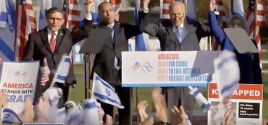District Court Says You Can (Probably) Photograph Police, But Only With A Regular Camera, Not A Droneby Tim CushingTechdirt Apr. 09, 2015 |
Popular 
Sen. Hawley: Send National Guard to Crush Pro-Palestine Protests Like 'Eisenhower Sent the 101st to Little Rock'

Mistrial Declared in Case of Arizona Rancher Accused of Killing Migrant Trespasser

AP: 'Israeli Strikes on Gaza City of Rafah Kill 22, Mostly Children, as U.S. Advances Aid Package'

John Podhoretz Demands National Guard Be Sent Into Columbia U to Put Down Pro-Palestine Protests

House Passes $95B Foreign Aid Giveaway to Israel, Ukraine and Taiwan, Combined With TikTok Ban
 You have a First Amendment right to film police officers and other public figures during their performance of public duties… except when you don't. Police officers are given the most deference in these matters, despite a handful of circuit courts upholding this right and the DOJ itself stepping in to inform police departments around the nation that, yes, citizens have a right to record police officers in public. But the "right" is loaded with exceptions, and it's not backed up by circuit court decisions in several states. To date, most courts have given law enforcement officers plenty of leeway to shut down recordings as they see fit and stay one step ahead of accountability. In February of last year, Pedro Rivera overheard a police scanner call for respondents to a serious traffic accident in Hartford, Connecticut. Rivera, a cameraman for a local news station, headed to the crash site and attempted to gather footage using his personal drone. This drew the attention of responding officers, who forced Rivera to remove himself and his drone from the scene. (They also suggested his employer could stay in their "good graces" by punishing Rivera for hovering by proxy 150 feet above the scene of the accident.) Rivera sued, claiming the police violated several of his rights, including his First Amendment right to film police officers performing their public duties. Connecticut's federal court has sided with the police officers, in effect declaring that those within the Second Circuit's coverage area don't have a right to film police -- at least not with a drone. As for his First Amendment claims, the court found that there was no recognized right to record police activity. While other circuits have split on the issue -- there is such a right in the First, Seventh, Ninth and Eleventh circuits -- the Second has never addressed the question, meaning that there could be no clearly established right as needed for the officers to waive their qualified immunity.Specifically, the court seems to have an issue with the type of camera used, rather than the act itself. Moreover, the Court notes that in cases where the right to record police activity has been recognized by our sister circuits, it appears that the protected conduct has typically involved using a handheld device to photograph or videotape at a certain distance from, and without interfering with, the police activity at issue. [...]The case cited quotes Congress as defining "public domain" airspace as somewhere between 500-1000 feet above the ground, depending on location, time of day, weather, etc. In the 1946 case, military planes were buzzing Causby's farm at less than 100 feet above the ground. The Supreme Court found in Causby's favor. This raises the question: would Rivera's photography have been protected if it had occurred above 500 feet? The district court has basically declared that an altitude of 150 feet is an "invasion" of the ground below it. Would going higher restore rights? Or would deference to law enforcement make an accident scene off-limits to aerial photography? This is where older rulings clash with new technology. The court plainly states that it would have viewed Rivera's photography more charitably had he been using a handheld camera, placing him closer to the accident scene than his drone ever was. Somehow, the fact that it was overhead seems to be what's holding the district court back from upholding Rivera's First Amendment rights. A height of 150 feet likely interfered with nothing more than the officers' sense of control. Because the police couldn't "rope off" the sky, they had to do the next best thing: order the flying camera and its operator away from the scene. The court says the camera "trespassed" into an active crime scene. But cameras do that all the time. The yellow tape may keep observers further away horizontally from crime scenes, but it does not prevent them from observing or filming any visible part of it. This decision gives police control over the skies, even when the circumstances don't demand it. They certainly have every right to ground a citizen's drone if it's interfering with police or medical aircraft, but otherwise it's just another camera -- in this case a camera 150 feet away from the nearest police officer. There's no interference happening here, and yet, the "right" to film police has been limited to only certain earthbound photography equipment -- and even then, still subject to any number of restrictions imposed arbitrarily by police officers. No First Amendment Drones (PDF) |



